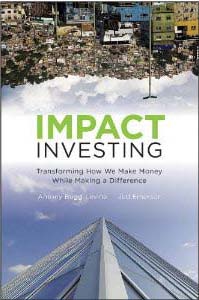
Ripples in the investment world are massing into a tidal wave of change in how we finance social good. It is a wave that will encompass investment brokers and philanthropists, venture capitalists and foundations.
To get a sense of what is happening and what still needs doing, read Impact Investing: Transforming How We make Money While Making a Difference by Antony Bugg-Levine and Jed Emerson. It is a framework for harnessing the swell of these waves into powerful forces for positive disruption.
There’s a growing belief that business practices can play a role in solving the most intractable social problems around the world. They already do in social enterprises funded by visionaries or sweat-equity. What Antony and Jed envision is change embraced by investors, philanthropists, entrepreneurs, and the public sector.
They point the way to creating positive impact without foregoing financial returns, by blending values in order to achieve both returns and impact. — your basic triple-bottom line philosophy — in a regulated, large-scale system that allows investment from every sector.
When you define an emerging field, you risk constraining the ongoing evolution of the field. It’s even trickier when what you’re defining crosses into multiple emerging fields, from micro-finance to social enterprise to measuring social impact. Yet, you can’t fully understand or leverage impact investing without messing about in all of them. And that gets very complex.
Antony and Jed take these complex relationships and drill down to their essence in a way that any layman can understand.
Failure is a great learning tool. One of the great things about this book is that it doesn’t flinch from mistakes that have been made. Instead, it uses them, as well as success stories, to bolster the notion that impact investing, implemented well, is the way out of the many global problems.
It’s important to note that impact investing is not a panacea. Some of the world’s problems, such as domestic violence, can best be solved by government and philanthropy. Others are just too big for government and philanthropy to solve.
Emerging models from the business world address these big problems in areas such as healthcare, affordable housing, education, agriculture, and utilities, among others. Mainstream investors haven’t joined in … yet.
Antony and Jed point out that the government must encourage new models through tax breaks, incentives and, maybe, even mandates and regulations to protect investors and entrepreneurs, and educate the next generation of leaders. Some of these undertakings may fail but, remember, failure is a teaching tool.
Where will the funding come from to do all this good stuff? Two streams are suggested:
- Typically only 5% of a foundation’s assets are given away in grants each year. The remaining 95% is reinvested. Imagine if that money was invested in social enterprises as debt or equity to provide both a social return and a financial one.
- The $80 trillion global capital market always wants investment options. Look to family foundations followed by private banks and their clients as the first movers. Moving institutional investors is like turning an ocean liner; they’ll follow, not lead.
This is massive disruption that I fully support. I am delighted to read about the progress made, the wrinkles ironed out, and the way forward. You will be, too, but I bet you have questions as well, so Ventureneer is hosting a free webinar presented by
Antony and Jed, Impact Investing: Challenges and Prospects.
How could your organization use impact investing, to fund solutions or to generate ROI?
